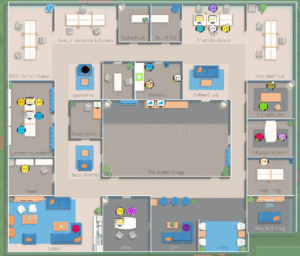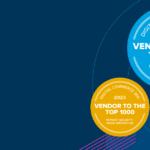Prior to Signifyd, I worked remotely at NASA Ames Research Center for five years. That job was wonderful and I wouldn’t trade it for anything.
It was also a typical remote experience — I was the one remote person on the team. My managers had to go out of their way to include me in discussions and I flew down for a week each month to stay on top of things.
When I joined Signifyd three years ago, a major attraction was that most of the engineering team worked remotely. Since then we have more than tripled the size of the team and are now split more evenly between remote and onsite engineers. Along the way we have refined and improved our social norms, our ways of interacting and our organizational structure to minimize the offsite/onsite distinction and maintain strong team cohesion.
One tool that’s proven surprisingly effective is Sococo, an app that gives us virtual office space and tools for communication. This screenshot shows a random day in the office:

With a glance, I can see in the top right that the ADE team is meeting, with one member sharing her screen. I can tell that a couple of teammates are having a video chat in the Falcon Heavy room and see that one person is away from his desk (Lunch, bottom left). With a click I could join one of the ongoing meetings, jump into the Ping Pong room to chat with the coworker there or move to the CoffeeBreak room to signal a short period away from my keyboard. Ordinarily, I’d also see my coworker’s names, but we’ve removed them from the illustration for privacy reasons.
When a virtual office feels like the real thing
It’s funny how much this feels like an office to many of us. If two people step out of a group room to continue a conversation, they’ll naturally step across the hall. When we had to move to a bigger virtual space, debates about layout were intense and there was a scramble (and some hurt feelings) when each team wanted to claim the best rooms — those with comfortable couches and decor. And we’re engineers!
It’s easy to get remote workers on board with a technology like this. The bigger hurdle is to make it work for those onsite. For example, they are asked to negotiate two work environments and choosing to be fully present with headphones on in Sococo sometimes doesn’t make sense, because it requires being less fully present in the physical office.
We’ve connected a physical room in San Jose directly to Sococo and played around with mics and headphones to improve audio in noisy settings. We encourage non-engineers to become fluent in the tool. My team’s product owner is a pro – if he has a question, he’ll pop into our team room turn on his camera and mic and speak up. Invariably one of us will engage and the rest can listen and chime in as necessary.
Despite the benefits and fun, Sococo is not a replacement for physical proximity and we constantly face the challenges of building successful teams across large distances. Onboarding for both onsite and remote engineers is more difficult. Managers need to handle the unique challenges faced by remote teams. Individuals need to become comfortable reaching out to a remote colleague as quickly and informally as they would to someone sitting at a desk beside them. Communication between individuals, teams and departments is a common topic in agile retrospectives; the ability to stay focused without losing context isn’t unique to remote work, but it is even more critical.
Those of us who work remotely really appreciate the effort that those throughout the company make to include off-site engineers in company-wide meetings and events. We’re incorporated into all-hands meetings, lunch-and-learn sessions and monthly cross-team lunch meetups. In addition to Sococo, the company has invested in hardware so that most conference rooms can be used with Zoom teleconferencing.
But some things are simply impossible when you work remotely. So, the entire engineering team gathers a few times a year at headquarters for a fun onsite week where we participate in workshops, do lots of whiteboarding and, most importantly, hang out and get to know each other.
Remote work recognizes real life
And, of course, there are advantages to working remotely. As long as remote engineers are available during the appropriate hours and getting their work done, an engineer could stay home to let in a plumber, skip a bad Bay Area commute to hunker down and focus on a big deadline or fly out of state to support a family member with a health concern. Remote engineers know they can work successfully from afar; no changes to team communication or daily rituals required. In fact, it’s great for everyone at the company to experience remote work at some point.
Our remote culture has been a work in progress since the company’s inception, with most of the original engineers, as well as several managers, working remotely. Heck, one of the founders still works from three time zones away! There’s no concern that the company will suddenly abandon this journey. We expect to continue to tackle unexpected challenges that arise, expand the suite of tools we use to communicate and evolve our teams to meet the onsite and offsite challenges of a growing company.





